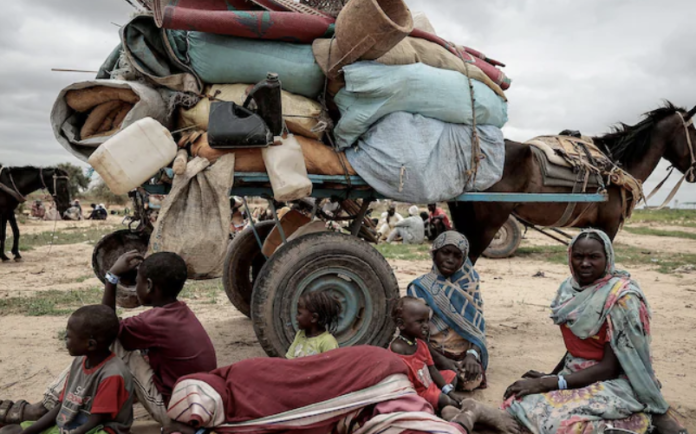While these two wars have absorbed the attention of major world news agencies (and this daily newsletter) over most of 2023, other crises were smoldering further. In Sudan and Myanmar, destructive civil wars, marked by many atrocities and reports of war crimes, destroy the already dysfunctional states and provoke humanitarian crises that grow in a spiral. On a wide strip of Africa south of Sahara, the region stirred ups and seizure of power. Social instability and postpandeper economic pressure have contributed to the splash of migration worldwide.
2023 will probably be the hottest year in the history of observations, when the waves of heat are covered by all continents, which will be accompanied by other extreme culminating events. Drought and floods were more sharp - the most shocking moment came, apparently, in September, when heavy rains led to the destruction of dams and sudden floods that took over 11,000 people in the northeast of Libya. "This catastrophe has a mythical scale," said Libya Health.
The face of such a disaster could be hoped that the New Year would bring the best news. But in 2024, much can go wrong, and many crises that will deteriorate. The war in gas is approaching a dangerous turning point. While Israeli officials promise a long campaign, the current fighting is pushing 2.2 million inhabitants of Gaza on the abroad. This territory is the most deadly place in the world for a civilian person. Until October 7, when the Hamas fighters' grouping struck the southern Israel, 80 percent of the Gaza population needed humanitarian assistance. Now everyone is doing it, and barely a trickle of what is needed falls into the besieged territory. Humanitarian organizations and many world leaders are calling for ceasefire and increasing the amount of humanitarian aid in gas. But if you do not stop the fighting, the war can shake the region by drawing anti -Israeli groups based in Lebanon and Syria, and giving rise to the unprecedented flow of Palestinian refugees to Egypt.
In his annual "Extraordinary Observation List", published this month, the International Salvation Committee evaluated the conflict in Israel and in the occupied Palestinian territories as the second most flashy crisis in 2024. The first was less discussed by the civil war in Sudan, where eight months of fighting between military countries and paramilitary forces of fast support led to the fact that more than half of the country needed humanitarian assistance and forced about 6 million people to leave their homes. About 19 million children do not have education because the conflict has led to the closure of thousands of schools.
"Sudan has become the world's largest crisis," Elshafi Mohammed Ahmed of IRC said in Elshafi. “The ability to provide assistance is complicated by the lack of humanitarian access and funds. Ethnic, tribal and regional polarization of the present war is even more threatened with limited access available at the moment. ”
Africa is home for the bulk of other potential hot spots, as indicated by the IRC. Three countries of the Flower Belt in West Africa-the junta of Burkina-Faso, Mali and Niger-all of which have been rated. The Burkinabes army fails to face the splash of Islamist warlike, when the travelers control more than half of the country. In Mali and Nigeri, where such dynamics are observed, the growing lack of food security and the exhaustion of foreign aid is pushed by millions of people in even more danger.
There are 86 percent of all people who need humanitarian aid around the world from the IRC surveillance list. The political instability that absorbs these societies hides the ghost of warming the planet, since drought and other climatic upheavals affect some of the most vulnerable communities in the world. "What was once a separate circle of crisis is now a Venna diagram with an expanding crossing," IRC President David Miliband wrote. “Three decades ago, 44% of conflicts occurred in climatic vulnerable states. Now this figure is 67%. "
Baiden administration most successfully kept the line in strengthening the support of the resistance of Ukraine to Russian aggression. But his opportunities for action will be limited in the year of elections that cause differences, and even Washington's ability to finance Kiev in doubt, not to mention his ability to bypass many crises in other places, from Somalia to Afghanistan and Haiti, which dominate the gangs, balancing on the verge of decay.
In Asia, Taiwan elections can be marked by new provocations from China at a time when Biden's administration tries to bring some stability to their relationship with Beijing. But the largest fire can happen in Myanmar, where the ruling junta is recovering from the offensive, started by a coalition of rebel militias, and sees growing desertion in its ranks.
However, the current trajectory "does not indicate the short -term collapse of the regime on the battlefield, in the absence of unforeseen events", said Morgan Michals, a researcher at the International Institute for Strategic Studies. Instead, Myanmar moves to a new phase of conflict marked by a weakened but still dangerous regime, more intense violence and more uncertainty. "


